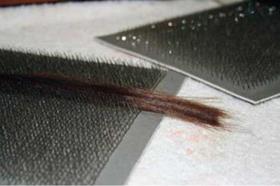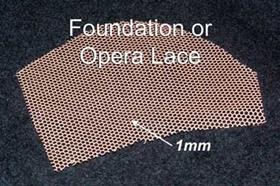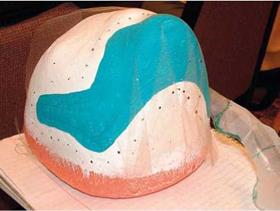There are several tools and materials that are essential for postiche boardwork if you are going to do any of the work yourself.


![]()
■ Drawing mats and drawing brushes. These two devices are designed to hold hair in place while you work to prevent wasting any hair by keeping it under control. When hair is placed between the brushes or mats, the longest hairs can be drawn out first.
■ Net foundation. Foundation comes in different varieties and is used by wigmakers for ventilating hair (hand tying) into; fine, flesh-colored nylon or silk lace is used for street wear, film, television, and studio work, and heavier flesh-colored nylon lace is used for theater, though often fine lace is used to front wigs for theater as well.
■ Ventilating needle. Also called knotting hooks, ventilating needles come in different sizes, all of them quite small; the size will depend on the number of hairs required in each knot. Size 00 is the
![]()
 finest needle and is used for finishing edges, drawing one hair at a time. Sizes 01 and 02 are used for main fill areas, drawing two or three hairs at a time. Larger needles can be used for drawing even more hair for areas where more hair is required without showing the hairline. A ventilating needle is actually a very tiny fish hook and is quite sharp and should be treated carefully so as not to accidentally hook yourself or someone else.
finest needle and is used for finishing edges, drawing one hair at a time. Sizes 01 and 02 are used for main fill areas, drawing two or three hairs at a time. Larger needles can be used for drawing even more hair for areas where more hair is required without showing the hairline. A ventilating needle is actually a very tiny fish hook and is quite sharp and should be treated carefully so as not to accidentally hook yourself or someone else.
■ Blocks. These include wooden blocks, malleable blocks, and beard blocks/chin blocks.
Wooden blocks are solid head-shaped figure 8.3
![]()
![]()
 forms for making wigs. A malleable block is head-shaped but soft and Various types of covered with canvas; these are usually used for dressing wigs. Beard/chin blocks can be made of either solid wood or soft canvas; these are chin shaped to facilitate beard work.
forms for making wigs. A malleable block is head-shaped but soft and Various types of covered with canvas; these are usually used for dressing wigs. Beard/chin blocks can be made of either solid wood or soft canvas; these are chin shaped to facilitate beard work.
